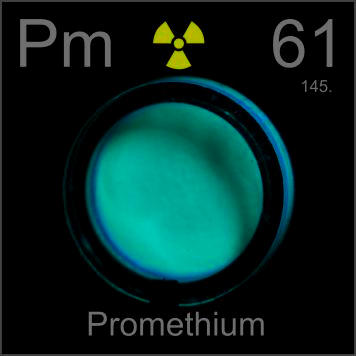Introduction to Rare Earth Element Promethium
Promethium is an interesting element when you consider its physical and chemical properties, as well as its occurrence and production. It is an extremely rare metal, with only about 500–600 grams naturally occurring in the earth’s crust at any given time. However, it is not stable and therefore undergoes radioactive decay, producing different isotopes. It is the only rare-earth, radioactive metal on the periodic table.
Promethium is classified as a rare-earth metal belonging to the lanthanide series. The element was discovered in 1945 by Jacob A. Marinksy, Lawrence E. Glendenin, and Charles D. Coryell, and was named after Prometheus of Greek mythology. Due to its limited availability and high radioactivity, it is mainly used in research applications. Some early researchers for the Manhattan Project in Oak Ridge in Tennessee identified the isotope promethium-147 in the byproducts of uranium fission. Their finding was later confirmed with a mass spectrometer and published in 1947.
Further Reading: Metal Encyclopedia: Seventeen Rare Earth Elements Introduction
Most practical applications of promethium are limited to only the chemical compounds of the isotope promethium-147, even though promethium-145 is the most stable isotope of promethium. These chemical compounds are used in making luminous paints, atomic batteries, and devices used for measuring thickness.

Properties of Rare Earth Element Promethium
Physical properties
- According to research, the metal is silvery-white in appearance. It forms salts that glow in the dark with a pale blue or green light.
- The element has very high melting and boiling points of 1908°F (or 1315 K) and 5432°F (or 3273 K), respectively.
- It has a density of 7.26 g.cm-3
- When forming compounds, the promethium atom (which contains 61 electrons) loses two of its outermost electrons and one of the 4f-electrons.
- Its atomic radius is the second largest among all the lanthanides. However, it is just slightly greater than those of neighboring elements.
- Many of its properties rely on its position among the lanthanides.
- The element has a double hexagonal close-packed structure with a hardness of 63 kg/mm2
Chemical Properties
The promethium element is pretty unstable, and this has limited the scope of studies focused on understanding the element, as well as its application in everyday life. Here are some known chemical properties of promethium:
- Promethium is a radioactive rare-earth element. It emits beta radiation. The element has multiple isotopes, all of which are radioactive in nature.
- When promethium is mixed with other elements, it forms salts, but it only shows reactions for one stable oxidation state of +3.
- The bombarding of enriched uranium with thermal neutrons produces promethium-147. When neodymium-146 is bombarded with neutrons, it produces neodymium-147. This beta decays over 11 days (its half-life) to become promethium-147.
- A few other radioactive materials have been synthesized from the promethium element. However, most of them have not been extensively studied, due to the instability of the metal.
- Acid solutions containing Pm3+ ions can be treated with ammonia to produce gelatinous light-brown sediment of hydroxide that is insoluble in water.
- Promethium dissolves in nitric acid to yield a nitrate, Pm(NO3)3, which is soluble in water, and when it is, it forms pink crystals.
- The sulfate of promethium is slightly soluble in water.
- The oxide of promethium is similar to the corresponding samarium salt instead of the neodymium salt.
- Upon heating to 600 °C, the powder crystallizes in a cubic lattice. It anneals further at 800 °C and 1750 °C, irreversibly transforming to monoclinic and hexagonal phases, respectively.
Applications of Rare Earth Element Promethium
- The application of promethium is mostly limited to research purposes because of the instability of its isotopes. Besides, it is relatively limited in supply. However, promethium-147, which is obtained in small quantities as oxide or chloride, does not emit gamma rays. Its radiation has a relatively small penetration depth in the matter and a relatively longer half-life than other isotopes.
- It is used for generating electricity in atomic batteries. The beta particles produced by promethium-147 are converted into electric current when a small promethium source is sandwiched between two semiconductor plates.
- The radioactive decay of promethium is used to make a phosphor to give off light, which is converted into electricity by a solar cell.
- Promethium can also be used as a source of x-rays and radioactivity in measuring instruments.
- In measuring instruments, promethium is used to measure the thickness of materials, by measuring the amount of radiation from a promethium source that penetrates and passes through the sample.
- The element is also used as a pacemaker. This is a luminous paint containing a phosphor. It is capable of absorbing the beta radiation emitted by promethium-147.
Wrapping Up
Promethium is the 61st element on the periodic table belonging to the lanthanide series of metals. The element occurs in various isotopic forms, all of which are radioactive. Promethium is very limited in supply in nature and is quite unstable. Because of this, most practical applications of promethium are limited to only the chemical compounds of the isotope promethium-147. But in general, the element is primarily used in scientific research.
If you want to know more about rare earth elements, we would like to advise you to visit Stanford Advanced Materials (SAM) for more information.




